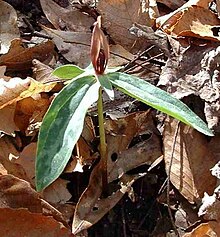| Trillium lancifolium | |
|---|---|

| |
| Gadsden County, Florida | |
|
Scientific classification
| |
| Kingdom: | Plantae |
| Clade: | Tracheophytes |
| Clade: | Angiosperms |
| Clade: | Monocots |
| Order: | Liliales |
| Family: | Melanthiaceae |
| Genus: | Trillium |
| Species: | T. lancifolium
|
| Binomial name | |
| Trillium lancifolium | |
| Synonyms [4] | |
|
T. lancifolium
| |
Trillium lancifolium, the lanceleaf wakerobin, [5] lance-leaved trillium, [6] or narrow-leaved trillium, is a species of plants native to the southeastern United States. It is known to occur in Alabama, Florida, Georgia, Mississippi, South Carolina, and Tennessee. [7] The species is imperiled in Alabama and Florida, and critically imperiled in South Carolina and Tennessee. [1]
Description
These plants are smaller than most other species in the genus, usually no more than 30 centimetres (12 in) tall, with comparatively inconspicuous flowers and leaves. As implied by both scientific and common names, the ( lanceolate) leaves are notably narrow, about 2.5 times as long as they are broad, with the widest portion being more-or-less central. The petals are usually maroon or brownish-maroon, quite erect, and more slender than in most other species of Trillium. [8]
Taxonomy
Trillium lancifolium was first described and named by Constantine Samuel Rafinesque in 1840. [3] As of March 2023 [update], the name Trillium lancifolium Raf. is widely recognized. [5] [8] [4] The species is a member of the sessile-flowered trilliums ( Trillium subgen. Sessilia), a group of species typified by Trillium sessile. [9]
Distribution and habitat
Trillium lancifolium typically occurs in shady upland hardwood forests, but can be found in various other communities with some shade. Populations are usually scattered, and the individual plants are often present at low population levels. [8]
Ecology
Trillium lancifolium blooms from February to May.
References
- ^ a b "Trillium lancifolium". NatureServe Explorer. NatureServe. Retrieved 16 November 2021.
- ^ "Narrow-leaved Trillium (Trillium lancifolium)". The IUCN Red List of Threatened Species, Version 2022-2. Retrieved 30 March 2023.
- ^ a b "Trillium lancifolium Raf.". International Plant Names Index (IPNI). Royal Botanic Gardens, Kew; Harvard University Herbaria & Libraries; Australian National Botanic Gardens. Retrieved 20 March 2023.
- ^ a b "Trillium lancifolium Raf.". Plants of the World Online. Royal Botanic Gardens, Kew. Retrieved 20 March 2023.
- ^ a b USDA, NRCS (n.d.). "Trillium lancifolium". The PLANTS Database (plants.usda.gov). Greensboro, North Carolina: National Plant Data Team. Retrieved 20 March 2023.
- ^ Stritch, Larry. "Lance-leaved Trillium (Trillium lancifolium)". United States Forest Service. Retrieved 7 October 2019.
- ^ "Trillium lancifolium". County-level distribution map from the North American Plant Atlas (NAPA). Biota of North America Program (BONAP). 2014. Retrieved 3 October 2019.
- ^ a b c Case Jr., Frederick W. (2002). "Trillium lancifolium". In Flora of North America Editorial Committee (ed.). Flora of North America North of Mexico (FNA). Vol. 26. New York and Oxford: Oxford University Press – via eFloras.org, Missouri Botanical Garden, St. Louis, MO & Harvard University Herbaria, Cambridge, MA.
- ^ Lampley et al. (2022), p. 282.
Bibliography
- Case, Frederick W.; Case, Roberta B. (1997). Trilliums. Portland, Oregon: Timber Press. ISBN 978-0-88192-374-2.
- Lampley, Jayne A. (2021). A systematic and biogeographic study of Trillium (Melanthiaceae) (PhD). University of Tennessee. Retrieved 10 February 2022.
- Lampley, Jayne A.; Gereau, Roy; Floden, Aaron; Schilling, Edward E. (2022-07-05). "A revised subgeneric classification of Trillium (Parideae, Melanthiaceae)". Phytotaxa. 552 (5): 278–286. doi: 10.11646/phytotaxa.552.5.1. S2CID 250368253.

